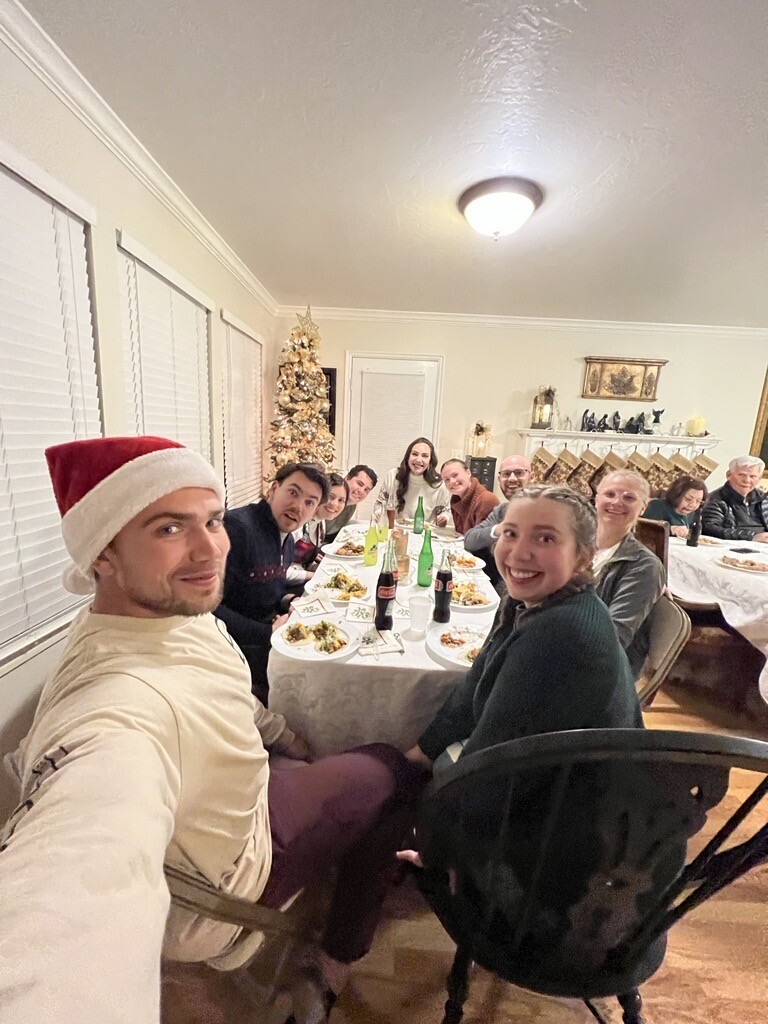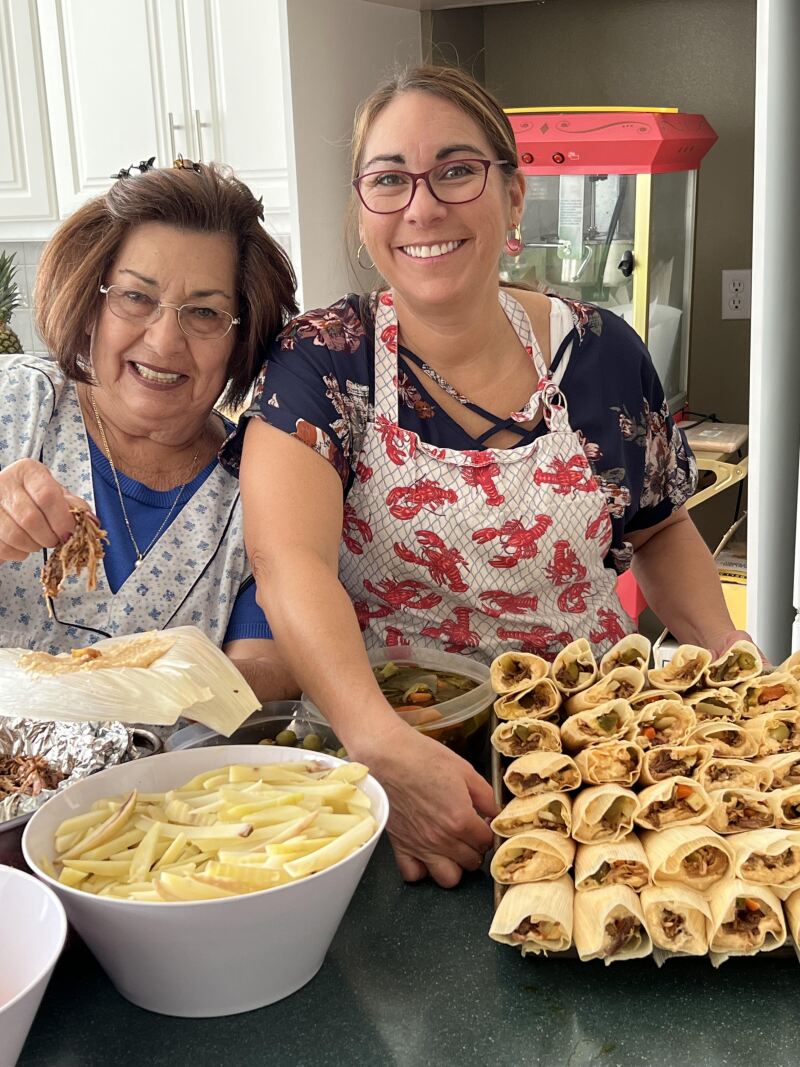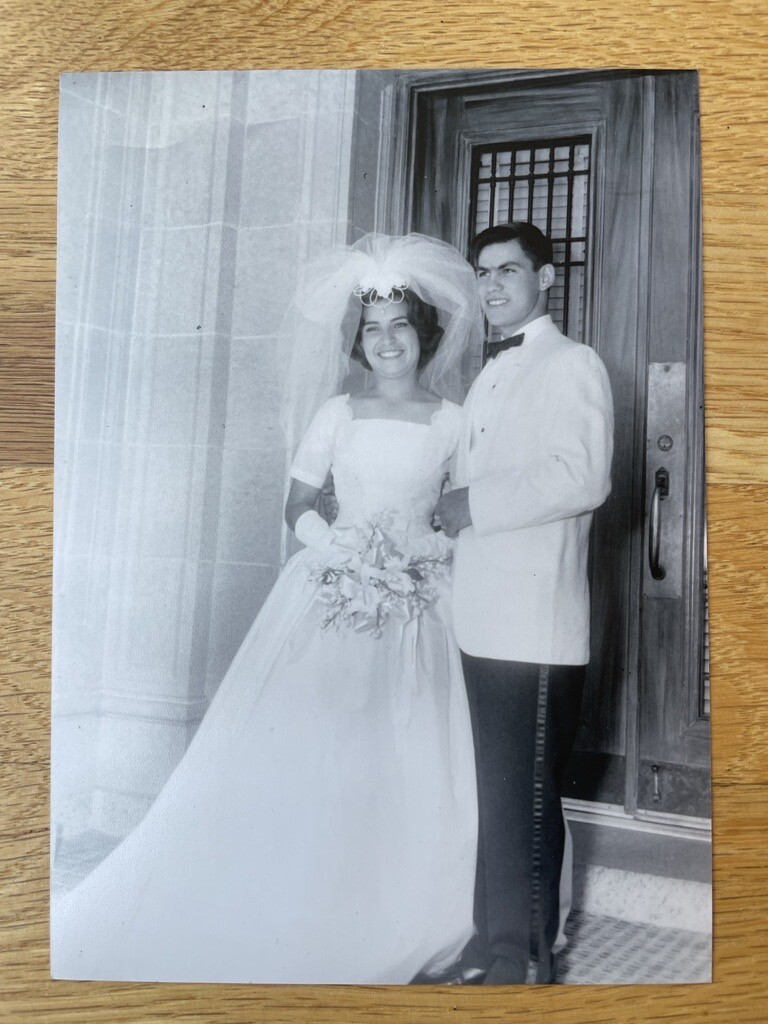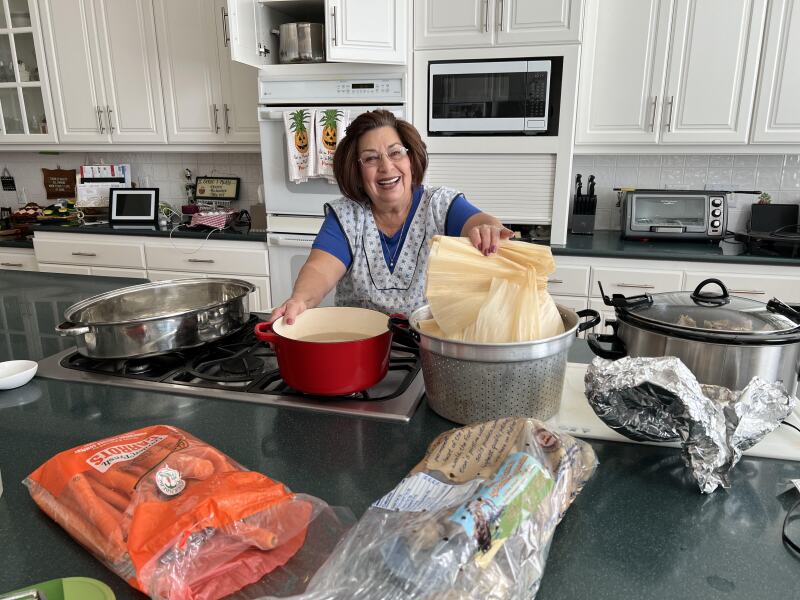The evening of December 24 is my favorite night of the year, and not because of anticipation for Christmas morning. For me, the magic of Christmas Eve comes from my family’s Mexican feast.
On that night, our home in Utah is filled nearly to bursting with light, warmth, close friends, and family as we celebrate our Hispanic heritage with a meal of traditional Mexican dishes. We squeeze around the table, count the total number of tacos consumed, and lament the all-too-quick filling of our bellies. Every year my grandma (Mima) arrives early, sometimes still wearing her apron, to warm stacks of her homemade tamales on the cast-iron griddle. My grandparents were born and raised in Mexico, and for them, it simply wouldn’t be Christmas Eve, Noche Buena, without tamales.
For years, I passed over Mima’s freshly made tamales, instead of filling my handpainted terra-cotta plate with more familiar foods: corn and flour tortillas, seasoned black beans, red and green salsas, cilantro rice, slow-cooked pork, and chopped limes to top it all off. It wasn’t until I was about 10 years old that I took a closer look at the traditional Mesoamerican dish made from corn-based dough and wrapped in steamed corn husks.
Noticing that I was eyeing the tamales one year, my mom began to tell me about the special role the dish has played in our family for generations. I knew my grandparents had immigrated from Mexico to the US in the ’60s. But what I didn’t know was that every Christmas since she was a child, my 5-foot-nothing Mima has spent days in the kitchen making tamales, preparing the masa, fillings, spices, and corn husks. The recipe came from her mother, Enriqueta, and Mima knows it by heart.
Tamales are also special to my mom. Though her childhood included moves from Utah to Mexico to the Philippines, tamales were always part of Christmas, bringing the comfort of familiar smells and tastes to new places. After listening to my mom talk, I raised the tamale to my mouth and took a bite. Any doubts I had melted away as my mouth was filled with savory and spicy flavors. After that, I looked forward to Mima’s tamales every year.
Looking back, I think there is something profound about my choice to taste Mima’s tamales that night: I didn’t decide to eat them because of the way my mom described their flavor. I wanted the tamale because of how my mom described the feeling of eating tamales at Christmas with people she loved. I wanted to feel that way too.
Since then, tamales have brought me a deep feeling of connection to my family—both to the Mima I know, and to the mothers and grandmothers who came before her, which in turn connects me to the Savior.

Whether your family makes tamales, decorates gingerbread houses, or sings carols at the piano during the holidays, you can be linked together by your traditions—and they don’t have to be costly or require a lot of time, either. So how do we establish meaningful traditions? We can find answers by looking at traditions through the lens of psychology and the lens of faith. My hope is that as we better appreciate what traditions can do for our families, we can all experience not only a more joyful, Christ-centered Christmas but a more joyful, Christ-centered life.
The Psychology of Traditions
For some families, Christmas can bring a level of pressure to succeed or even impress. I myself have given in to the belief that in order to truly celebrate the holiday I have to execute every tradition perfectly, down to the placement of ornaments on my tree.
So I think it is important to realize right away that perfect execution isn’t required. Dimitris Xygalatas, a psychologist who has conducted extensive research on rituals and traditions, teaches that the most important function of holiday rituals is their role in maintaining and strengthening family ties. Notice that he doesn’t say that the most important function of holiday rituals is to “wow” your friends or family by pulling off a stunning event.
I can see what Xygalatas means. Before our Mexican feast, I spend hours with my family in the kitchen preparing all the food: shredding the pork, cooking the beans, chopping the onion and cilantro garnish, setting out the traditional Mexican plates and bowls with hand-painted designs, heating dozens of tortillas, mixing the Mayan hot chocolate, warming the tamales on the griddle, and eventually opening a kitchen window to let the cold December air dispel the faint smoke that has accumulated over the kitchen stove.
To anyone else, our pre-feast scene may look more chaotic than glamorous as dishes pile up and some recipes don’t turn out quite right—but it’s the stuff of my Christmas dreams. Spending time simply being with my family strengthens our relationships and renders the meal that much more enjoyable.

But how does a tradition as simple as working in the kitchen hold such power? Fortunately, it isn’t because of my spiritual aptitude or access to unlimited resources. Traditions anchor and connect families because they are meaningful makers of identity and group membership. Michelle Brennan, a clinical psychologist and professor, wrote that “holiday traditions are essentially ritualistic behaviors that nurture us and our relationships.” I had never considered family traditions to be ritualistic; I generally associate rituals with religious practices, such as partaking of the sacrament. But it makes sense: just as religious rituals enhance my spiritual experience and relationship with God, my Christmas traditions strengthen my family experience and relationships, too.
Our Mexican feast doesn’t just bring me closer to my family—it also lifts me out of the distracting hustle and bustle of the season so I can better focus on Jesus Christ: the source of our Christmas joy. And feeling a connection to my family and the Savior brings me a deeper sense of purpose and satisfaction than even the most perfectly executed tradition ever could. I know that can be true for you, too.
Faith and Traditions
When Paul wrote his second epistle to the Thessalonians, he said to them, “Therefore, brethren, stand fast, and hold the traditions which ye have been taught” (2 Thessalonians 2:15). Paul couldn’t be with the Saints all the time, but he knew that holding to good traditions would keep them going in the right direction. And while Paul was likely speaking of religious traditions, perhaps he was also encouraging the Thessalonians to hold to the wholesome traditions that governed other aspects of their lives and complemented their spiritual growth.
I believe this is because holding on to traditions connects families across distance and time, which strengthens our faith in God. Elder Ulisses Soares has taught, “As you seek to discover and pass down who you are, and from where and whom you came, you will come to know who He is—your Savior Jesus Christ; and I promise you that you will find purity and peace, perspective and purpose, and you will find power and place in the family of God.”
Elder Soares’s promise has certainly proved true for me. Learning more about my Mima’s story, and even the role tamales play in it, has given me an inspiring example of faith to follow—especially when I learned that Mima’s tamale tradition brought her connection and comfort after she joined a new faith and started a new life.
Mima always thirsted for spiritual truth. Born into the Catholic faith, she even considered becoming a nun. Her search for spiritual fulfillment eventually led her to curiously eavesdrop as Latter-day Saint missionaries taught her sister Esperanza and brother-in-law Alonzo about the gospel. At first, Mima declared that she wasn’t interested in the elders’ message, but she wanted to learn more once she heard the elders say that families could be together forever. So at age 18, she began meeting with missionaries too.
When Mima told her parents she was going to be baptized into The Church of Jesus Christ of Latter-day Saints, they did not support her decision. And when Mima married my grandpa in the Mesa Arizona Temple on September 3, 1964, most of her disapproving family did not attend. Though their relationship had become strained, Mima’s mother, Enriqueta, did wait outside the temple and helped Esperanza host a reception at the local chapel.

Mima spent Christmas that year in Utah with her new in-laws—far from her family in Nogales, a small border town in Arizona. And while it was difficult for my grandma to be away from those she loved during the holidays, she did have a part of them with her: she had her mother’s recipes. That Christmas Eve was the first time Mima made tamales by herself.
“I wanted to have a Christmas like I had at home,” Mima said, reflecting on that time. “So I made tamales.” Even though her relationships with her own family weren’t perfect that Christmas, the tamales reminded Mima of the love she had for her family and that some way, somehow, everything would work out in the end.
My life experiences are different from Mima’s, but, like her, I need both the Savior’s love and my family to not only endure but also overcome life’s challenges. As I learn about the people and stories behind my family traditions, I’m reminded in a tangible way of where I come from and how I can be faithful in life, just like Mima and the many ancestors before me.
This year, as I place one of Mima’s steaming tamales on my Christmas Eve plate, I won’t just be looking forward to their comforting flavor. The tradition will remind me of my grandma’s life, her conversion, her struggles, and her faith. I hope I’ll be inspired by her example to both connect with my family in good and not-so-good times and cling to my faith all year long.
No matter our family’s circumstance or time of year, traditions can bring a family- and Christ-centered focus to our celebrations and daily lives. As you celebrate this Christmas season and ring in the new year, I hope you will use your traditions to connect with your loved ones and our loving Savior—even if it’s through something as simple as a homemade tamale.
▶ You may also like: 5 nativity traditions your family will want to start doing every year


